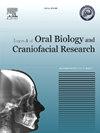Comparative efficacy of LLLT and LED therapy on osteoblast proliferation and osteoclast suppression: An in vitro co-culture study
Q1 Medicine
Journal of oral biology and craniofacial research
Pub Date : 2025-02-11
DOI:10.1016/j.jobcr.2025.01.018
引用次数: 0
Abstract
Background
Dental implants are a reliable solution for tooth loss, but challenges remain regarding osseointegration and complications. Photobiomodulation therapy (PBMT), including Low-Level Laser Therapy (LLLT) and Light Emitting Diode (LED) therapy, has shown potential in enhancing bone healing. However, comparative studies on their effects on osteoblasts and osteoclasts are limited.
Aim
To compare the effects of LLLT and LED therapy on osteoblast proliferation and osteoclast suppression in an in vitro co-culture model.
Materials and methods
MG-63 osteoblast-like cells and RAW 264.7 osteoclasts were co-cultured on titanium discs. Discs were treated with LLLT (940 nm, 50 mW) or LED (660 nm, 89 mW) for different durations. Osteoblast proliferation was measured by MTT assay, and osteoclast activity was evaluated using TRAP staining and resorption pit analysis.
Results
LED therapy significantly enhanced osteoblast proliferation and suppressed osteoclast activity more effectively than LLLT. Optimal results were observed with a 6-min LED exposure.
Conclusion
LED therapy shows greater potential than LLLT for promoting osteoblast proliferation and suppressing osteoclast activity, indicating its clinical value for improving bone regeneration and implant integration.
LLLT和LED治疗对成骨细胞增殖和破骨细胞抑制的比较疗效:体外共培养研究
牙种植体是牙缺失的可靠解决方案,但在骨整合和并发症方面仍然存在挑战。光生物调节疗法(PBMT),包括低水平激光治疗(LLLT)和发光二极管(LED)治疗,已经显示出促进骨愈合的潜力。然而,它们对成骨细胞和破骨细胞影响的比较研究有限。目的比较LLLT和LED治疗对体外共培养模型成骨细胞增殖和破骨细胞抑制的影响。材料与方法将smg -63成骨样细胞与RAW 264.7破骨细胞在钛盘上共培养。椎间盘用LLLT (940 nm, 50 mW)或LED (660 nm, 89 mW)处理不同时间。MTT法检测成骨细胞增殖,TRAP染色及吸收坑法检测破骨细胞活性。结果与LLLT治疗相比,led治疗可显著增强成骨细胞增殖,抑制破骨细胞活性。LED曝光6分钟,效果最佳。结论led治疗在促进成骨细胞增殖和抑制破骨细胞活性方面比LLLT有更大的潜力,提示其在促进骨再生和种植体整合方面具有临床价值。
本文章由计算机程序翻译,如有差异,请以英文原文为准。
求助全文
约1分钟内获得全文
求助全文
来源期刊

Journal of oral biology and craniofacial research
Medicine-Otorhinolaryngology
CiteScore
4.90
自引率
0.00%
发文量
133
审稿时长
167 days
期刊介绍:
Journal of Oral Biology and Craniofacial Research (JOBCR)is the official journal of the Craniofacial Research Foundation (CRF). The journal aims to provide a common platform for both clinical and translational research and to promote interdisciplinary sciences in craniofacial region. JOBCR publishes content that includes diseases, injuries and defects in the head, neck, face, jaws and the hard and soft tissues of the mouth and jaws and face region; diagnosis and medical management of diseases specific to the orofacial tissues and of oral manifestations of systemic diseases; studies on identifying populations at risk of oral disease or in need of specific care, and comparing regional, environmental, social, and access similarities and differences in dental care between populations; diseases of the mouth and related structures like salivary glands, temporomandibular joints, facial muscles and perioral skin; biomedical engineering, tissue engineering and stem cells. The journal publishes reviews, commentaries, peer-reviewed original research articles, short communication, and case reports.
 求助内容:
求助内容: 应助结果提醒方式:
应助结果提醒方式:


